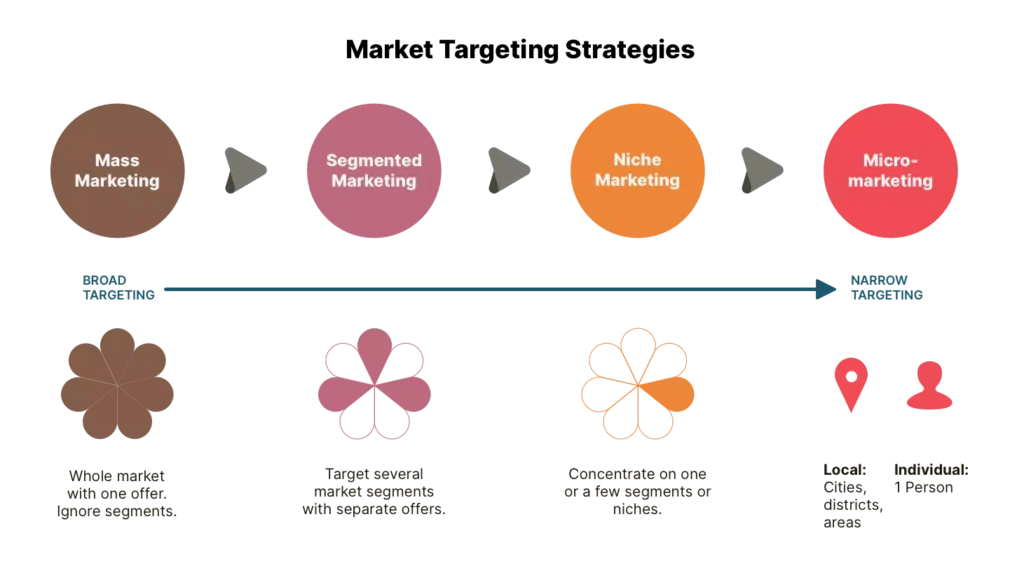We have learned in the section Market Segmentation that a company cannot serve all consumers in the total market. Their variety and their needs are simply too large. Therefore, we have segmented the market, by dividing it up into small segments. Now, we should target those segments we can serve most efficiently and effectively: Market Targeting. This is the second step of setting up a marketing strategy.

After having distinguished between the separate segments in a market, the company can select one or more of these segments to enter. Before doing this blindly, each segment should be assessed. Therefore, targeting is concerned with evaluating each segment’s attractiveness for the company and selecting one or more segments to enter.
The evaluation of segments is based on the question of which segment the company can serve best. In other words, we should concentrate on and enter those segments in which we can generate the greatest customer value over time.
Whether a company decides to enter one or more segments may also depend on its resources. If these are limited, it may be better served to focus on one or a few smaller segments, which we call market niches. In the best case, the company should look for segments competitors overlook or ignore.
Alternatively, a company can decide to enter several segments. This may be based on a strong relation between the segment in terms of resembling needs, or on the company’s widespread resources. For instance, clothing companies often target more than only one segment: males, females, children, and so on. A large company such as a major car manufacturer might even decide to serve all market segments by offering a complete range of products.
The Market Targeting Process
We will now look at the process of Market Targeting in two simple steps. Firstly, we have to evaluate the market segments. Then, we select target market segments. This last step goes hand in hand with choosing the targeting strategy.

1. Evaluating Market Segments
As said, we start with the market targeting process by assessing the different segments we identified in the market segmentation. But based on which criteria do we evaluate the segments? In assessing market segments, a firm should consider three factors. These are:
- The segment size and growth
- The segment’s structural attractiveness
- The company objectives and resources.
To evaluate segments, the company needs to collect and analyze relevant data first. This data may include information on current segment sales, growth rates, and anticipated profitability of segments. But even if we have these data, what is the right size and the right growth for our company? The largest or fastest-growing ones? Or small niche segments?
No answer applies to every company. In fact, it depends on the company itself. Therefore, the company objectives and resources are as important as the segment size, growth, or structural attractiveness. A smaller company could lack the skills and resources necessary to serve a large segment. Such a small company might find that segment too competitive, not fitting its strategy. Therefore, some companies will focus on small segments that might appear less attractive to outsiders. For the company, though, it may be a more attractive and profitable choice.
In addition to the segment size and growth, its structural attractiveness plays a significant role in market targeting. The major structural factors that are meant here affect the segment’s long-term attractiveness. These structural factors are nothing else than the 5 Forces of Porter. With the 5 Forces model, the attractiveness of a market based on five factors can be assessed.
Applied to market targeting, we first look at the competitors that are present in the segment. Clearly, a segment is less attractive if it already contains a high number of strong or aggressive competitors. In addition to competition, the existence of substitute products is important. The threat of substitution could limit prices and the profits we can earn in the segment. The bargaining power of buyers is also an influencing factor on the segment’s attractiveness. If their bargaining power is large, they may force the company to lower prices and offer more they might set competitors against one another – not a favorable situation.
Finally, the power of suppliers affects the segment’s attractiveness, since powerful suppliers can control the prices, quality, and quantity of the goods we need.

Certainly, a favorable size, growth, and structural attractiveness of a segment are not all in market targeting. It has to match the company’s objectives and resources. If it does not fit the company’s long-term objectives, why should we enter it? We might also lack the skills and resources that are required to succeed in a segment, even if it is attractive.
An example: the economy segment of the automotive market is quite strongly growing. Nevertheless, it would not make that much sense for a company such as Ferrari to enter this segment. The reason simply is that the company would not be able to create superior customer value in this segment. Instead, it will be much more profitable for the company to focus on segments that meet its objectives and strategy.
2. Selecting Target Market Segments
After having assessed the identified market segments, we can now go on with selecting the most profitable ones for the company. First of all, what is a target market? It refers to one set of buyers who share common needs or characteristics the firm decides to serve. So, the company has to decide which and how many segments it will target.
Thus, we arrive at the actual core activity of market targeting. Market targeting can take different forms. These are referred to as levels of market targeting. A firm can target very broadly, which is called undifferentiated marketing. Market targeting can also be very narrow, which is called micromarketing. If it is somewhere in between, it might be differentiated or concentrated market targeting.
Market Targeting Strategies
We will now look at these four different market targeting strategies that go hand in hand with the segments we choose.

Undifferentiated (Mass) Marketing – Broad Market Targeting
If we look at the whole market as a pie, following the undifferentiated market targeting strategy, we would focus on the whole pie. We would not select the slice that appears to be most delicious but try to eat all of them. Thus, there is no targeting at all.
Following an undifferentiated (mass) market targeting strategy, the company decides to ignore differences between market segments and focus on the whole market with one offer. Therefore, the firm has to focus on what the whole market has in common in terms of the needs of consumers, rather than focusing on what is different. Since the company wants to address the whole market, it needs to design a product and a marketing program that will meet the needs of and appeal to the largest possible number of buyers.
There might be some doubts about whether this market targeting strategy is the right one. Certainly, difficulties can arise in developing a product that is capable of satisfying all consumers. In addition, companies that follow this strategy often struggle to compete with those companies that pursue a more focused strategy. Those focused companies simply do a better job at satisfying the unique needs of specific segments and niches, whose presence cannot be denied.
Differentiated (Segmented) Market Targeting
A differentiated market targeting strategy means that we decide to target several market segments and also design separate offers for each. To return to our previous example, the pie, we would now select the most delicious ones and focus on eating these.
Most large companies follow the differentiated market targeting strategy. For instance, a car company produces several different models of cars, and often even offers different brands. Fiat, for example, consists of more than the core brand Fiat. Think of Ferrari, Alfa Romeo and Lancia. Each brand targets its own segment of car buyers. P&G, to give another example, markets more than one detergent brand, each targeting a different segment. Thus, we select several segments to serve and design separate offers for each.
The reason for pursuing this market targeting strategy is that higher sales and a stronger position within each segment can be the consequence. Certainly, a strong position within several segments generates higher total sales than undifferentiated marketing across all segments. However, differentiated market targeting strategies also increase costs. These come from the fact that different offerings have to be developed for each segment. Instead of producing one product 10,000 times, the company has to produce 10 products 1,000 times each. Also, the development of separate marketing plans for each segment involves additional research, analysis, planning, and forecasting. Consequently, the company should weigh increased costs against the benefits when deciding on a differentiated market targeting strategy.
Concentrated (Niche) Market Targeting
To stay with our example: If we do not want to eat the whole pie or several slices, but only one small slice that has a special criterion others do not have such as a nut on top, we go for the concentrated (niche) market targeting strategy.
Following the concentrated market targeting strategy, the company focuses on one or a few segments or niches in a market. The aim is then to reach a large share in this segment or niche, instead of going after a small share of a large market.
Why should a company do so? It will be able to achieve a stronger market position in the chosen segment because its knowledge of the consumer needs in the niche is larger. Also, it may acquire a special reputation for delivering exactly what the consumer wants in that niche. The company can fine-tune its products, marketing programs, and prices to the specific needs of consumers in the niche. Therefore, its marketing becomes more effective. But marketing may also become more efficient because the company can tailor its offerings, channels, and programs to the needs of those consumers it can serve best and most profitably.
The difference between a niche and a segment is the size. While a segment is rather large and will in most cases attract several competitors, a niche is quite small and may be focused on by a few competitors only. Niching thus allows especially small companies to focus their limited resources on serving niches. The key is to find those niches that are overlooked by larger competitors.
Micromarketing – Narrow Market Targeting
In our example, micromarketing would mean to eat the nut on the already special slice only.
Micromarketing means nothing else than tailoring the marketing programs and products to the needs and wants of individual consumers or local customer segments. This is the narrowest market targeting strategy possible. Instead of seeing a customer in every individual, we see the individual in every customer. We can tailor our products and programs to suit the tastes of specific locations of specific individuals. Therefore, micro marketing can take the form of local marketing and individual marketing.
Under the local marketing strategy, we tailor brands and promotions to the specific needs and wants of groups of local customers. These may be cities, neighborhoods, etc.
The most extreme market targeting strategy option is individual marketing. Then, we tailor our marketing programs and products to the needs of individual customers. This is also called one-to-one marketing, markets-of-one marketing, and mass customization. Today, this customization for individual customers is facilitated by new technologies, such as databases, robotic production, and flexible manufacturing.
In micromarketing, relationships with the few customers the company focuses on are of utmost importance. The company can simply not afford to lose one of the few, but highly profitable customers.
The Choice of the Market Targeting Strategy
Which market targeting strategy is chosen depends on many factors. None of the strategies above works best in every situation. Rather, the market targeting strategy depends on several characteristics of the company. When choosing a market targeting strategy, the company should consider:
- The company’s resources. If resources are limited, a concentrated market targeting strategy might make more sense.
- The degree of product variability. In the case of uniform products, such as apples or steel, undifferentiated marketing may be more suited. In the case of products that can vary in design (cars, cameras, etc.), more narrow differentiation and concentration are suitable.
- The product life cycle. When a company introduces a new product, it may be helpful to launch only one version. Undifferentiated or concentrated marketing might make the most sense. In the mature stage, a segmented market targeting may be appropriate.
- Market variability. If you talk about a kind of product where all buyers have the same tastes, buy the same amounts, etc., undifferentiated marketing makes sense.
- Competitors’ marketing strategies. If competitors apply differentiated or concentrated market targeting strategies, using undifferentiated marketing may prove to be fatal. However, the firm might also gain an advantage by using a different market targeting strategy than competitors, especially if it can serve individual customers better by meeting their needs. Then, a concentrated market targeting strategy or micromarketing will work best.




